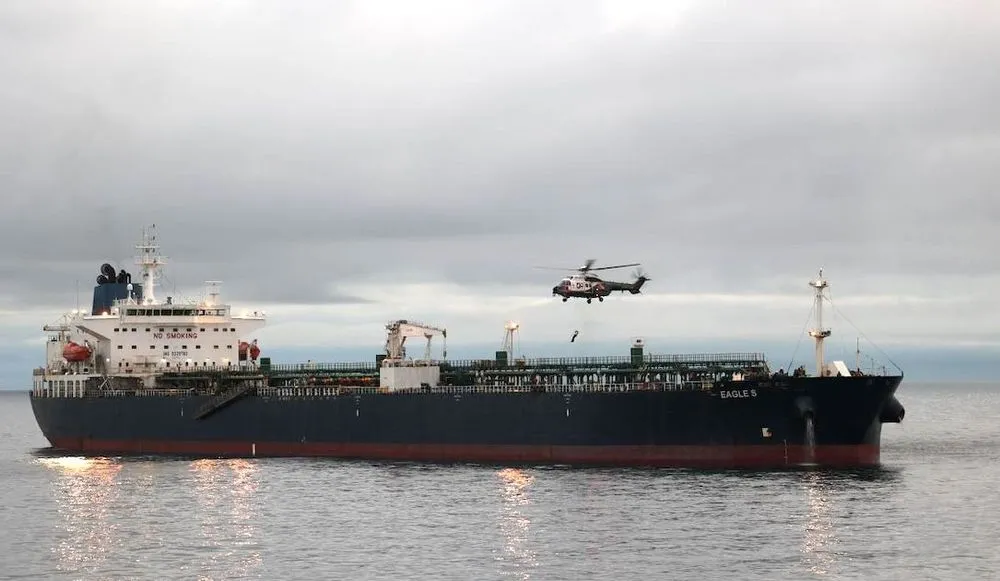Finland could charge Russia-linked ship’s officers over cable breaks by ‘August at the latest’
Three men detained in Finland since Christmas Day after their ship severed multiple subsea cables in the Baltic Sea could be charged with criminal offenses within the next two months, according to the country’s prosecution authority.
Jukka Rappe, Finland’s deputy prosecutor general, said prosecutors expected to make their decision over whether to bring charges against the men by “August at the latest” in a statement sent to Recorded Future News.
The suspects, who are believed to be Georgian nationals, were the three most senior officers on board the Eagle S, a Russia-linked oil tanker. The ship was seized by Finnish authorities after dragging its anchor along the seafloor for almost 62 miles, amid concerns over Russian sabotage and subversion activities in Europe.
Armed police subsequently boarded the vessel via helicopter and officers from Finland’s National Bureau of Investigation (NBI) seized a range of physical and digital evidence and detained the crew for interrogation. The three suspects were told to remain in Finland although the rest of the crew and the ship were freed to depart in March.
The NBI announced on June 13 that its criminal investigation had been completed and had upheld the suspicions of aggravated criminal mischief and aggravated interference with telecommunications.
According to Finland’s Criminal Code, which does not contain a specific offense for sabotage, aggravated criminal mischief carries a minimum prison sentence of two years and a maximum of 10, while the sentence for aggravated interference with telecommunications ranges between four months and five years.
Officials from several European countries on the North Sea and Baltic Sea previously told Recorded Future News their governments were increasingly confident that recent submarine cable breaks in the region have been accidental and caused by increasing maritime traffic linked to sanctions against Russia over its invasion of Ukraine.
The decision to formally charge the three men rests with prosecutors. Rappe said: “Pre-trial investigation of the Eagle S case has been completed, and the case transferred to the Office of the Prosecutor General for consideration of charges. The discretion of the prosecutor is expected to be completed in August at the latest.”
The Eagle S had also been investigated by Traficom, the Finnish transport and communications agency, which said it had inspected the ship and identified deficiencies aboard, both in terms of its crew accommodation and the general maintenance of the ship, particularly in regards to fire safety, navigation equipment and pump room ventilation.
The oil tanker is reported to have been previously used as a Russian spy ship and to be part of what Western countries describe as Russia’s “shadow fleet” — a collection of up to 1,000 decrepit vessels with opaque ownership structures that sail under flags of convenience to export sanctioned Russian goods, particularly oil.
Trouble in the Baltic Sea
The cable breaks on Christmas Day followed a month after a Chinese cargo ship named Yi Peng 3 is believed to have broken the C-Lion1 cable, and a year after another Chinese ship named Newnew Polar Bear damaged a subsea gas pipeline between Finland and Estonia, highlighting how vulnerable subsea cables are to sabotage as well as to accidental cuts.
Another cable-breaking incident in January saw Swedish authorities seize a cargo ship called the Vezhen which had been suspected of sabotaging a communications link running between the Latvian city of Ventspils and the Swedish island of Gotland.
That ship was released just a week after the incident, with prosecutors stating: “The investigation now clearly shows that it is not a case of sabotage. It has been established that a combination of weather conditions and deficiencies in equipment and seamanship contributed to the cable break.”
While there is growing confidence that several recent submarine incidents were legitimate accidents, Russian sabotage and subversion activity is designed to be deniable — although investigators and intelligence agencies have been able to identify links to the Kremlin in several cases involving arson at facilities in Europe.
Announcing military activity to protect Baltic Sea infrastructure in January, NATO allies hedged on the cause of the Baltic Sea incidents: “We are deeply concerned by actions, be they negligent or malicious, which cause damage to or threaten the functioning of critical undersea infrastructure. We strongly condemn acts of sabotage to critical undersea infrastructure.”
The Russian government has dismissed claims it is behind the cable break incidents as “completely groundless” and accused NATO of creating “the preconditions for the introduction of arbitrary restrictions on international shipping in the Baltic Sea.” No such restrictions have been publicly proposed by NATO.
Alexander Martin
is the UK Editor for Recorded Future News. He was previously a technology reporter for Sky News and is also a fellow at the European Cyber Conflict Research Initiative.



